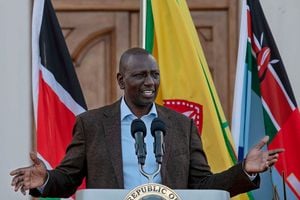
Kenya’s exports to UK increased by 15.1 per cent to $973.33 million in 2023 from $845.82 million in 2022.
Kenya faces a fresh round of global shocks that is risking more than $1.2 billion worth of exports destined to three of the world’s biggest economies teetering on the edge of a recession over rising interest rates, muted foreign demand and slowing domestic investments.
Also at stake are millions of dollars’ worth of Official Development Assistance (ODAs), foreign direct investments (FDIs) and diaspora remittances that are critical for shoring up the country’s foreign exchange reserves, reducing imported inflation and strengthening the shilling exchange rate.
The spillover effects of the UK, Japan and Germany economic crises are likely to jeopardise the government’s efforts of bolstering its foreign reserves that have fallen below the statutory threshold of four months of import cover and reverse the gains being made by the shilling against the US Dollar.
Kenya’s forex reserve stood at $7.03 billion (equivalent to 3.8 months) of import cover on February 15, according to CBK data as shilling rapidly gained ground against the greenback from a low of Sh162 to Sh142.
The United Kingdom (UK), Germany and Japan, which collectively buy about $1.2 billion worth of Kenyan goods annually, are at the centre of economic debates over the macroeconomic challenges that have pushed them into a recession by recording two consecutive quarters of gross domestic product (GDP) contraction.
“Most of these economies are major trading partners with Kenya hence trade imbalances,” said Samuel Nyandemo, Senior Lecturer at the University of Nairobi (UON)’s School of Economics.
“More importantly the funding to Kenya shall drastically shrink along side effects of the flow of foreign direct investments (FDIs) and remittances.”
Britain, the largest European foreign investor in Kenya, slipped into a recession after its GDP fell 0.3 per cent in the final three months of 2023, following a 0.1 per cent contraction in the July-to-September period.
The Bank of England (BoE), however, said on Tuesday the economy was showing signs of recovery from the mild recession and would further receive much support when interest rates start falling later this year.
“The impact on Kenya will be felt in two ways; reduced demand in those markets (for instance horticulture products, flowers), reduced donor funding and reduced foreign direct investments (FDIs) flows from these countries,” said Ken Gichinga, Chief Economist at Mentoria Economics.
Japan unexpectedly fell into a recession in the last three months of 2023 as its GDP contracted by 3.3 per cent and 0.4 per cent in the third and fourth quarters of 2023 respectively.
Germany’s Central Bank warned last week that the country’s GDP is likely to shrink slightly in the first quarter of this year.
Its real GDP shrank by 0.3 per cent in 2023, with weak foreign demand and high energy costs weighing on industry and exports, according to the bank’s monthly economic report (January 2024).
The UK is among Kenya’s Top 10 bilateral development partners, providing $90.89 million of bilateral Official Development Assistance (ODA) in 2021 and $617.32 million worth of foreign direct investments (FDIs) in 2023.
Kenya’s exports to UK increased by 15.1 per cent to $973.33 million in 2023 from $845.82 million in 2022, according to Kenya-UK Trade and Investment Fact Sheet (2023).
These exports comprise crude animal and vegetable materials, vegetables and fruit, coffee, tea, cocoa, and mechanical power generators.
On the other hand, Germany is one of the most important export destinations for Kenya and remains the number two economic partner in Europe after the UK.
Kenya exported $149 million worth of goods to Germany comprising cut flowers, coffee, and nuts in 2021 according to an online data platform Observatory of Economic Complexity (OEC) World.
Kenya’s exports to Germany comprise mainly primary agricultural products without or with less value addition. These are coffee, cut-flowers, fish, tea, spices, fresh fruits and vegetables.
Other products include handicraft, semi-precious stones and textiles.
A big percentage of exports into the German market enter the country through third countries in the European Union (EU), especially the Netherlands, where specialised import and auction houses are well established.
Such exports include cut-flowers, tea, fruits and vegetables, which come into Germany through their agents or suppliers in the Netherlands and France.
Kenya’s exports to Japan in 2023 stood at $79.93 million (cut flower, tea, coffee, nuts), according to data from the Japanese Ministry of Foreign Affairs.
Kenya is also the largest recipient of Japanese ODA in Africa in the form of ODA Grant Aid, loan aid and Technical Corporation.
UK and Japan’s ODA’s to Kenya are estimated at $90.89 million and $55.28 million per annum respectively, while foreign remittances from Germany and UK to Kenya are estimated at $148.19 million and $278.94 million per annum respectively.
According to CBK remittance inflows increased to Kenya stood at $412.4 million in January 2024 compared to $372.6 million in December 2023, and were 18 per cent higher than in January last year (2023).
The cumulative inflows for the 12 months to January 2024 totaled $4.25 billion compared to $4.03 billion in the same period in 2023, an increase of 5.3 per cent.
The US remained the largest source of remittances into Kenya, accounting for 54 per cent in January 2024.









